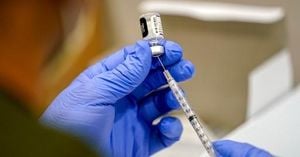Researchers have developed advanced methods to identify early warning signs and dynamic network biomarkers for type 2 diabetes using individual samples. Specifically, the study applied cutting-edge techniques to detect the pre-disease state, termed the 'critical state', which holds significant promise for effective intervention and prevention of this pervasive metabolic disorder.
Type 2 diabetes is marked by the body's inability to effectively use insulin, which can lead to numerous health complications if not managed early. Traditionally, the progression of diabetes is staged from normal to pre-disease and eventually to disease states. The 'critical state' acts as the tipping point just before the onset of overt diabetes, where timely actions can make the difference between health and disease.
Utilizing data from the GEO database, researchers focused on two datasets related to type 2 diabetes which involved analyzing gene expression profiles to pinpoint this dangerous threshold. Led by Peiyu Li and colleagues, the study employed three novel methods: single-sample Jensen-Shannon Divergence (sJSD), Network Information Gain (NIG), and Temporal Network Flow Entropy (TNFE).
The significance of this research lies in the nuanced approach to detecting early-stage diabetic changes. According to the authors, "The proposed three methods can effectively detect the ‘critical state’ and identify the dynamic network biomarkers (DNBs), solely based on a single sample." This is particularly important as traditional methods often require multiple samples and can miss the temporal changes occurring as diabetes approaches its pre-disease state.
By analyzing data from individual lymphocytes of rats with induced diabetes, the researchers were able to detect key transitions at 8 and 16 weeks for adipose tissue, and at 4 and 16 weeks for muscle tissue. These findings correlate with known clinical phenomena such as insulin resistance and declining pancreatic function, thereby demonstrating the real-world applicability of this research.
The core difference among the employed methodologies lies within their sensitivity and robustness when faced with noise. The sJSD method proved particularly sensitive to identifying the 'critical state', whereas the NIG and TNFE methods exhibited greater overall stability and effectiveness under varying data conditions. The study emphasized, "sJSD method is more sensitive to the ‘critical state’, whereas NIG and TNFE methods are more stable and effective."
By focusing on the specifics of gene expressions and network analyses, the study successfully highlighted dynamic network biomarkers indicative of transitioning toward type 2 diabetes. For example, genes associated with insulin signaling and inflammation were identified as DNBs during the early stages, promoting greater vigilance around their activity levels for clinical practitioners.
Implications of these findings extend beyond theoretical knowledge. They provide actionable strategies for early detection and intervention strategies to combat type 2 diabetes effectively. Spending resources on patients identified through these biomarkers could lead to preventative measures and more personalized healthcare, thereby mitigating the overall economic burden of diabetes on healthcare systems.
Concluding, this research marks a significant stride toward recognizing the importance of identifying the early signs of complex diseases such as type 2 diabetes. The dynamic nature of the methods discussed offers a new avenue for clinicians and researchers to explore, emphasizing the proactive management of pre-disease states through advanced data analyses.
Overall, the study lays down compelling foundations for future research aimed at enhancing diabetes care. The intersection of individual sample analyses and network theory provides unique insights, which could revolutionize how pre-disease conditions are approached.



